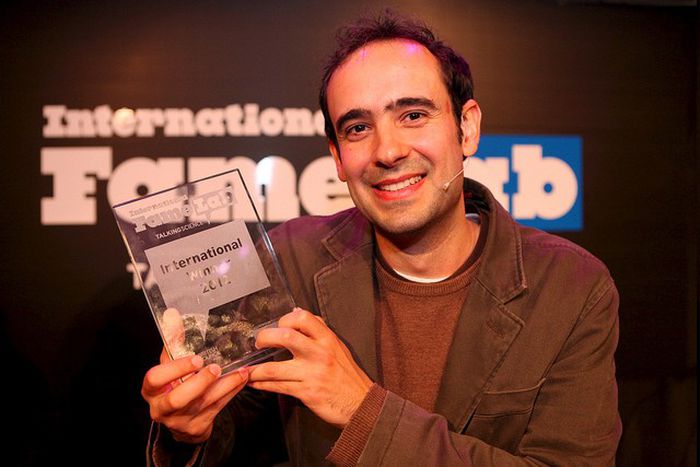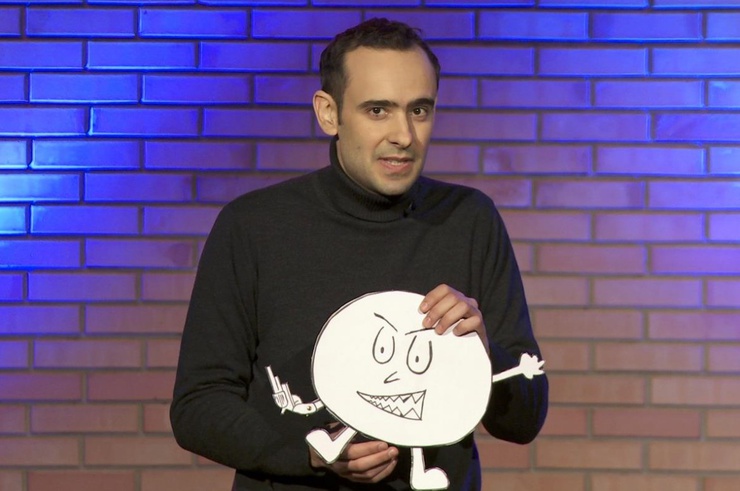
Didac Carmona: 'It's fascinating that a cell in the body commits suicide to keep the body alive'
Published on
Translation by:
 Richard Burck
Richard Burck
As long as bread and beer doesn’t disappear during a meal in the afterlife, the death of a yeast cell will keep having little importance to most people. Nevertheless one young researcher from Barcelona, who is based in Austria, has managed to excite audiences in this topic, earning the biochemist the 2012 'FameLab' top science communicator award
The young Spaniard laughs. It is summer and we are sitting in an idyllic coffee shop in Graz. One week earlier, the furia rojawon the 2012 UEFA European football championship and dizzily played its opponents with their special brand of Spanish tiki taka. Like its football players, Spain’s researchers are also world-class. Didac Carmona Gutiérrez, a young 32-year-old researcher, won the international Famelab competition for Austria at Cheltenham science festival in England. At Famelab, young scientists from 19 countries around the world gathered to present their current research under the motto 'Reduce to the max'. Whoever thinks these lectures sound boring have never experienced the programme, which was adopted by the British council three years after its creation in 2004. At the contest, the presenters are so exciting and understandable, they even inspire laymen with science - and Didac did a damn good job in his three-minute presentation.
Suicidal yeast cells heal cancers
The boy from Barcelona who moved to Styria, in south-eastern Austria, followed all the Spanish team’s 2012 Euro games and is a passionate football player himself. Football aside, we get onto the topic of what is so interesting about yeast cells, and why their death can help contribute to healing Alzheimer’s and cancer. 'In the beginning everything had to do with my parents and sister Celia,' he says. 'I wanted to make absolutely clear what I study and work on in the lab.' He stays occupied with science communication, helping out also at a public laboratory at Graz university for children and adults which is run by his friend and colleague Helmut Jungwirth. This brought him to FameLab.
'I find it fascinating that a cell in the body commits suicide to keep the body alive and healthy,' remarks Didac. He studies what happens if a mechanism doesn’t function properly and what can be done to remedy it. If a mutated cell in particular stops destroying itself and grows uncontrollably, a tumour can develop. If cells die that are difficult to recover, like nerve cells for example, neurodegenerative diseases such as Alzheimer’s, Parkinson’s or Huntington’s disease can develop. The process of ageing also relates closely with cell death.
Why just yeast?
'Yeast being a model organism for cell death sounds strange at first,' admits Didac. After the discovery of this process fifteen years ago, the science community was also sceptical at first. 'If a cell in the body has a problem, it is understandable that this cell, kills itself,' he continues. 'It's how the body is able to remain healthy. The mechanism has an intuitive purpose. Yeast is more complicated. As a single cell, a yeast cell is supposedly the whole organism- practically the body itself. So how does it make sense for a yeast cell to kill itself? A yeast cell is not completely independent from the cells they surround as many believe. Damaged cells kill themselves to avoid using up more resources and to allow the healthy cells to pass on the intact genetic material defined by the cell community. It is fascinating how often discoveries with yeast cells can be directly transferred to human cells. What’s more, knowledge of baker’s yeast in the area of cell death can partly be applied to other solitary cells especially pathogen fungi and also solitary-cell parasites, which can further help fight against various diseases.'

Didac faced many detours along the biochemistry road. He attended a bilingual school in Barcelona to which he owes his perfect German. After high school, the German state of Baden-Wuerttemberg offered him a scholarship. His interests in school were broad. In addition to the natural sciences, he also became interested in the humanities. Aside from acquainting himself with philosophy, football and biochemistry, he met Frank Madeo, the founder of cell death research with yeast, while he was studying in Tübingen. He received an invitation to assist Madeo and decided to answer the call. When Didac came to Graz for the first time in February 2005 - a city his friends praised as having a Mediterranean heart - he was welcomed with two metres of snow and the harshest winter in years.
'I’m pleased when I get to pass on the fascination in research'
Summers like this year’s with the Mediterranean flair of the 'Mur metropolis' (after the river Mur running through Graz - ed) have been great for Didac. Whilst the yeast colonies are maturing in the lab, Didac kicks a ball around with his friends, writes poems and short stories, or works on his international music project 'silentdeviation'. He also plays volleyball because his girlfriend Maria approves; she for her part scooped a FameLab 2012 award too: her 'audience award' matches her boyfriend's 'jury prize'. 'I’m pleased when I get to pass on the fascination in research,' he concludes. In any case we will view ourselves, Dr. Didac and our morning toast completely differently from now on.
Images: © famelab.at/2012/ video (cc) famelab/ youtube
Translated from Jungforscher Didac Carmona-Gutiérrez: Vom Selbstmord der Hefezellen


